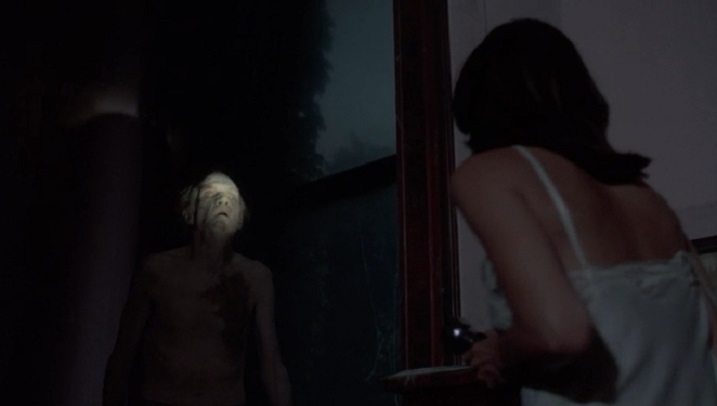
This January, in support of the Toronto Rape Crisis Centre / Multicultural Women Against Rape, friends and family have raised over $1,500 (which, when matched by my employer, totals $3,000). As a result, I now have to watch and write about thirty-one horror movies: one each night. Any donors who contributed over $30 were given the option to choose one of the horror movies I must subject myself to. After each viewing, I will write some things about said movies on this website. Be forewarned that all such write-ups will contain spoilers, and many of them will refer to unpleasant and potentially triggering situations. Today’s film, selected by friend, freelance editor, and writerr Catherine Chen is a late 1970s American oddity, The Sentinel (1977), directed by Michael Winner (Death Wish). I rented The Sentinel digitally from YouTube, as it was a bit difficult to find in other formats.
What happens:
Trigger warnings: suicide.
The prologue to The Sentinel begins in rural Europe, where a secret cabal of Catholic priests from around the world have met. They begin to chant what seems like a sacred oath, all while looking very worried about looming evil. Then viewers are whisked away to the heart of all evil: 1970s New York City!
Alison Parker (Cristina Raines) is a high-profile fashion model, with regular commercial spots and cover shoots for the likes of Esquire and Harper’s Bazaar. Her longtime boyfriend, Michael Lerman (Chris Sarandon, Humperdinck himself!), works as a lawyer. Though they’ve been together for two years – ever since Alison’s mysterious (to us) stay at the hospital – Alison isn’t interested in moving in with Michael. They both hunt for apartments, with Michael intending to find a shared love nest, but Alison more interested in finding a room of her own. Interestingly, one of the priests from the European cabal, Monsignor Franchino (Arthur Kennedy), follows Alison during her apartment hunt.
All these real estate good times grind to a halt when Alison receives a phone call from her mother that her father is dying. Before long, Alison is back at her palatial childhood home for her father’s funeral, but an intense migraine prevents her from going to the actual burial. After her family leaves, she has a flashback of herself as a teenager, walking in on her father, in flagrante delicto with two women who are not her mom. Her dad gets up from his complicated lovemaking and slaps Alison a few times across the face for barging in, then tears the crucifix from her neck and tosses it to the floor. Alison, in emotional distress, then runs to the washroom and slits her wrists. Luckily, her father (dressed only in a towel) discovers her moments afterward and calls for an ambulance.
Back in the present, Alison finds her old crucifix and begins to wear it again. While her boyfriend Michael is away working on a case (defending a convertible enthusiast), Alison decides to stay on the apartment hunt and meets with a realtor, Miss Logan (Ava Gardner), who shows her a fully furnished, giant brownstone apartment that is selling for a mere $500 a month. (This same apartment probably costs $25,000 a month today.) This is a bit more than Alison is willing to pay, and Logan quickly drops the price to $400 a month. (The landlords are motivated renters, apparently.) As they hash out details on the sidewalk, Alison notices an old man in the building’s top apartment staring at her. Miss Logan assures her it’s just Father Halliran (John Carradine), a mostly senile, retired Catholic priest who is entirely blind.
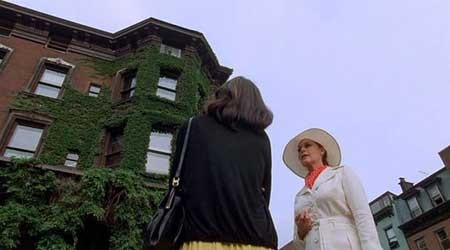
After securing her bargain of an apartment, Alison begins to experience further headaches, and passes out during photo shoots. She soon meets her neighbours, starting with Charles Chazen (Burgess Meredith), a local busybody with a pet parakeet (Mortimer) and cat (Jezebel). He gives himself a tour of Alison’s apartment and tells her all the tenants are swell, save the priest on the top floor, who he doesn’t much care for. That night, as a friend mounts a slideshow of his recent vacation, Michael asks Alison to marry him, and she politely declines.
Alison then meets the downstairs neighbours, a pair of Germanic lesbian dancers, Gerde and Sandra, who invite her in for tea. Gerde, in a thick Teutonic accent, notes that Michael “seems an adequate lover,” while Sandra doesn’t speak at all; she just masturbates furiously in front of Alison while Gerde takes a phone call. Alison continues to experience devastating headaches at work and it begins to cost her gigs. (A commercial director played by Jerry Orbach with a skeezy moustache certainly isn’t impressed by her uneven performance.)
The next night, Alison is invited by Charles to a birthday party for his cat, Jezebel, and she meets all the remaining neighbours, none of whom make Alison feel anything but deeply uncomfortable. Following the party, Alison has a terrible nightmare. When she wakes, she hears footsteps and loud noises from the apartment above, and her chandelier sways wildly. The next day, she tells Michael about her terrible night. She also sets up an appointment with her realtor, Miss Logan, to complain about all the weird neighbours and the loud noises that bother her in the night. That’s when Miss Logan drops a bomb: there are no other tenants in the building. Just Alison and the old priest, Halliran!

Speaking of Father Halliran, he receives a visit from Monsignor Franchino, who cryptically informs him that he’s arrived to relieve him of his burden. Miss Logan offers to give Alison a tour of the building to show her just how unoccupied it is. When Logan opens up the rooms, they’re all vacant, with sparse or completely different furniture. Even Charles Chazen’s apartment is covered over in cobwebs. Alison asks how the old priest sustains himself, and Miss Logan reveals that the Diocesan Council of New York City owns the building and takes care of Halliran’s needs. Michael, meanwhile, hires shady P.I. James Brenner (Hank Garrett) to investigate Alison’s claims of the strange sounds through the night.
We don’t see Brenner enter the building, but we do see Alison awake from another nightmare to the sounds of heavy footsteps at 3:30 in the morning. This time, she takes a knife and flashlight and heads into the hallway in her nightdress. The first gruesome discovery she makes is Jezebel making a bloody meal out of poor bird Mortimer. But she continues on, undaunted, and enters Chazen’s vacant apartment to make a second gruesome disocvery. A ghoulish figure enters in the dark and strolls past her. Alison follows the figure and discovers it’s a zombified version of her dead father. He attacks, and Alison fights back, stabbing him in the arm, slicing across his eyeball, and even cutting off his nose (to spite his face, one would assume). She flees the building, covered in blood, and screams frantically. Residents of nearby buildings race out into the night to help her (which was nice to see, because you can’t really expect people in 1970s New York to do that).
Alison, given her unreasonable story, is admitted to the hospital. The New York City Police decide they might need to get involved. Detective Gatz (Eli Wallach) and Detective Rizzo (a very young Christopher Walken) interview Michael in a hospital waiting room and imply Alison’s public freak-out is somehow his doing. After all, they have a past with Michael Lerman. We learn Michael’s ex, Karen, jumped off a bridge to end her life, and that Alison (who Michael was having an affair with at the time) also attempted suicide (for a second time) when she learned of Karen’s death. Seems like Michael has a deadly effect on the women in his life. But Alison’s story, they say, is nonsense. The blood she was covered in was her own, and she claims to have stabbed her father, who died three weeks earlier.
Things take a quick turn to the police procedural. As already established, Alison claimed to have met a number of nonexistent tenants in the building. The police have a list of their names, and soon discover a strange connection. One of the women, Anna Clark, is a convicted murderer who was executed in 1949. Then the gumshoe, James Brenner, turns up dead in a car crash. The police look into Brenner and discover he was a former cop, fired for corruption. What if Brenner was Michael Lerman’s hired goon, tormenting the ladies in his life? They confront Michael with the death scene photos of Brenner, but Lerman claims he’s never seen the man before.
Alison enters a Catholic church where she meets Monsignor Franchino, and he takes her confession right there on the church floor. Alison outlines her past of adultery and attempted suicide: “I rejected Christ. I need to come back.” The Monsignor assures her that Christ will protect her if she decides to return to the church. When she returns home, Michael suggests they look through the apartment building again and try to figure out what happened the night of the stabbing. He’s gained access to the place using keys provided by one of his clients. (Michael has some very shady friends.) They return and Michael discovers Alison is seeing things that aren’t there. Notably, she finds all the books inside only feature the same Latin phrase written over and over. He asks her to read out the Latin words she sees, and Michael transcribes it to be translated later.
The doddering old Professor Ruzinsky (Martin Balsam) tells Michael it’s an older Latin (pre-Caesar): a passage from Paradise Lost (which is very post-Caesar) – in fact, it’s the same passage the secretive Catholic cabal was chanting earlier: the angel Gabriel’s warning to the angel Uriel, who guarded the entrance to Eden. Alison goes back to find the Monsignor from that very same cabal and discovers he’s not the priest at the church. The real priest has never seen him before. Curiouser and curiouser. We’re deep into Dan Brown territory now, with Michael entering the Diocesan Council and demanding answers about Father Halliran, the Latin phrase, everything. But they only stonewall him as if he were the Boston Globe. So Michael devises an alternate plan.
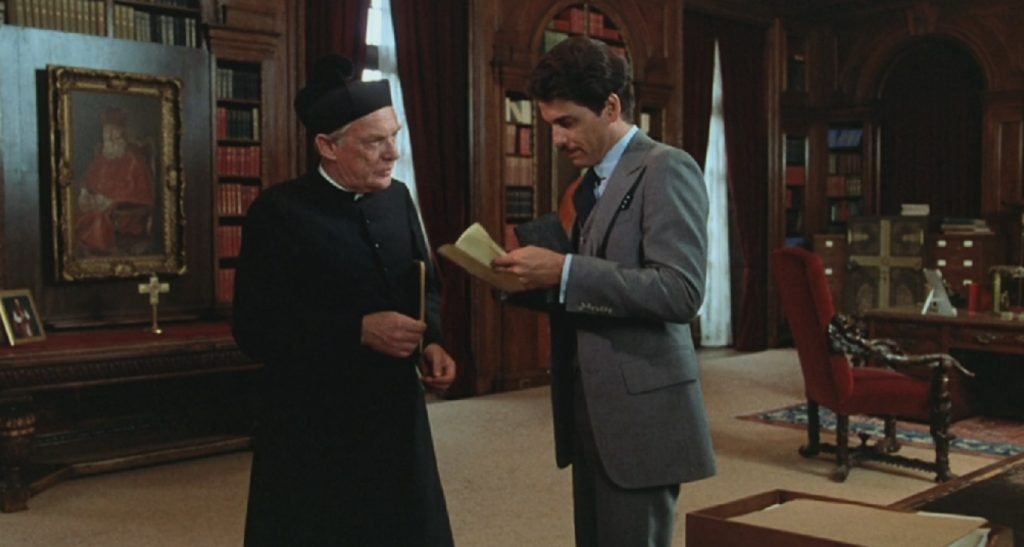
That evening, Michael hires another of his questionable accomplices to break into the Diocesan Council. They go through their secret files and find Father Halliran used to be one Dan O’Rourke, an average joe who attempted suicide, but afterward disappeared from the public record. In fact, the files are full of people who attempted suicide, went missing, then reappeared as priests and nuns, living in Diocesan Council properties. Each one dying the same day the next person became a member of the holy order. And worse: there’s an unfinished file featuring Alison’s 8×10 glossy listed under “Sister Teresa.” She’s next!
Complicating matters, Alison is obligated to attend a fashion industry party that night. Michael, knowing that Alison has been essentially scheduled to join the sisterhood against her will the next morning, figures the party is a bad idea, but tells her friend Jennifer (Deborah Raffin) to not let Alison out of her sight – especially after midnight. Then he hops into his Mercedes-Benz and heads out on a secret mission.
The police have since discovered that every one of the tenants Alison can name, save the old priest, is a long-dead murderer. Michael arrives back at the old apartment – this time wielding a crowbar. He goes to the basement’s entrance and pulls down the boards that have been nailed over it. What was covered up was a message (in English; not Latin): “Abandon all hope, ye who enter here.” He’s then startled by the blind priest, Halliran, who’s made his way downstairs, and blurts: “The entrance to Hell!”
Michael has about had it with this apartment building. He frog-marches Father Halliran back up the stairs to his room and shouts at him to explain what’s happening, threatening to kill him if he doesn’t. Then he escalates to choking the old priest, and that’s when the Monsignor arrives. Back at the fashion party, Alison screams and passes out (as per usual). Her friends put her into the bedroom to rest, and moments later, she goes missing. She’s wandered out of the building and back to her old apartment. When she arrives, she finds Michael’s bloody cufflinks (“ML”) on the main floor and screams. Without hesitation, she locks herself in her old place.
Feeling she’s entered the belly of the beast, Alison kneels at her bedside and prays to God for help. Then she hears someone stirring and hides herself in the closet, clutching at her crucifix. But when the closet doors open, it’s only Michael. He extracts her from the closet and explains what he knows so far: Father Halliran is a guardian to the entryway to Hell and the tenants she claimed to have seen were devils who were trying to drive her to suicide. It’s the only way the devils will win and escape into our world. At this point, it becomes clear Michael is acting a bit strangely. He confesses he’s dead himself, and the camera pans over to a gaping wound on the side of his head. He was recently killed by the Monsignor for choking Halliran, and now he’s a devil himself. After all, he’s a sinner. He killed his ex-wife, he admits.
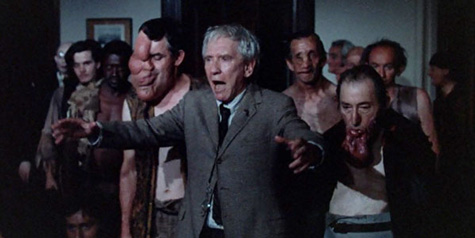
Fleeing from her devil boyfriend, Alison runs into Charles Chazen, back again, who seems to be ringleader of the devils. He calls up more devils from hell – half ghoulish tenants who we’ve seen before, and half random people with severe facial deformities (which is – to say the least – problematic). The ghouls also include – of course – Alison’s dear old dad, more corpsified than ever. But we also see the Germanic lesbians feasting on Michael’s corpse and her father’s lovers covered with rats.
Alison runs all the way to the top floor, where the devils surround her. Chazen presses a knife into her hand, encouraging her to just kill herself. Alison is moments from slashing her wrist when the Monsignor and Father Halliran arrive, holding aloft a crucifix the size of an eight-year-old boy. They make their way through the moaning devils and hand off the cross to Alison. At this, the devils shriek, many bleeding openly from their faces. Chazen hurls his knife into the devil Michael’s neck and they all retreat downstairs.
An epilogue features the building being demolished, and Miss Logan showing an entirely different apartment to a young couple. They ask about the other tenants, and Miss Logan notes there’s just a reclusive nun, Sister Teresa, on the top floor. The final shot of the film shows us Alison, now blind (for some reason) and wearing a nun’s habit, staring out the window across the harbour.
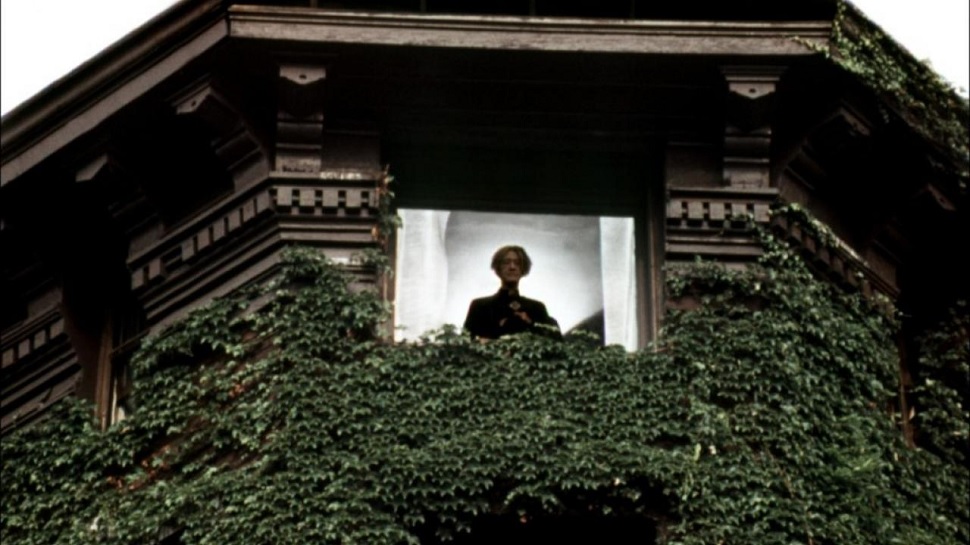
Takeaway points:
- What intrigued me most about the themes of The Sentinel is that for people to serve as sentinels, as gatekeepers between Hell and Earth, they need not have particularly strong faith, but do need to have attempted suicide. This is an unusual criterion for a Catholic job. Is it because these sentinels will have committed a mortal sin, but returned to the Church? Have they been closer to Hell than others? Whatever the reason – perhaps its explained in the book – I do like the idea of people who have attempted suicide depicted not just as troubled souls, but also heroes – in fact, they’re humanity’s last hope.
- That said, though the Catholic Church are presented as the ‘heroes’ of this film, they are troubling heroes. For one, they’re extremely secretive, but I guess that’s to be expected in matters of Heaven and Hell. (Opus Dei and all that.) But the definition of ‘sin’ in The Sentinel is quite narrow (or perhaps a strict product of its time). For so exploitative a film (this is the guy that directed Death Wish, after all), it seems bizarre that lesbianism and adultery are positioned as some of the more reprehensible, unfathomable sins. Alison’s skin simply crawls when she meets Gerde and Sandra. (But then, she’s also unsettled by twins.) How can so prurient a film revel in so prudish a message? Furthermore, the Monsignor Franchino literally kills a man: Michael. (And that’s right in the Ten Commandments.) Michael Winner has somehow made a skeezy exploitation flick that was probably endorsed by the Catholic Church. Or certainly could be.
- As hinted before, there is the issue of casting people with deformities as ‘demons’ who emerge from Hell. Even at the time (1977) it justifiably earned the film some bad press. After all, this is not a situation like Tod Browning’s Freaks, in which people with birth abnormalities are the principal characters of the film, given both plot and development. These actors show up five minutes from the end of the film, with no names and no dialogue, merely to scare the more squeamish in audience. They are presented as objects of fear and disgust and nothing else, and that directorial decision can’t just be overlooked.
- Coincidentally, the book that The Sentinel is based on, by Jeffrey Konvitz, features largely in a very good chronicle of the horror paperback publishing boom, Paperbacks from Hell by Grady Hendrix. It’s essential reading if you like weird horror stuff.
- The opening title font makes The Sentinel look like The $entinel, and I could not for the life of me figure out why. Unless the filmmakers were just being entirely up-front and honest about their efforts to cash in on 1970s Catholic horror chic.
Truly terrifying or truly terrible?: There are scenes that are terrifying. The sequence when Alison wanders the apartment building at night and encounters a zombie version of her dad is pure nightmare fuel. And the film is generally unsettling. In ways, it reminded me of an American Suspiria. But it’s also weirdly uneven and some of the acting could use a little work (in particular, Cristina Raines and Chris Sarandon, as the iffy anchors of the movie). It’s certainly an interesting movie worth seeing, with a few genuine scares, but not the forgotten masterpiece you may have been led to believe.
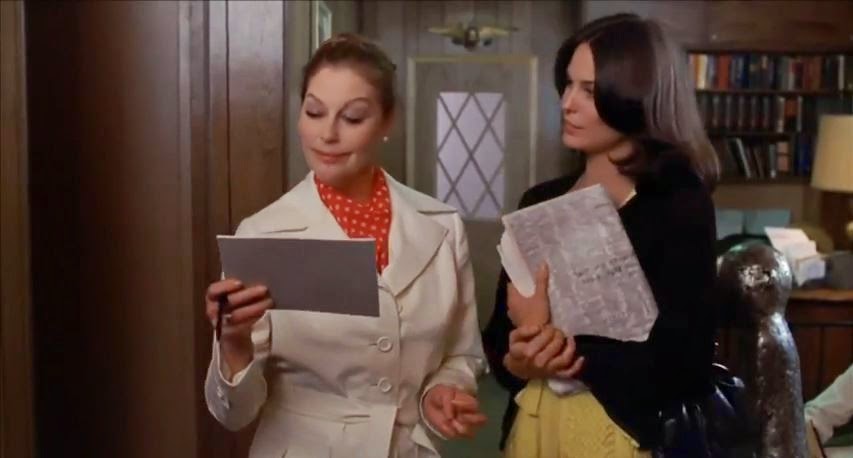
Best outfit: Given Alison is a fashion model, she wears a lot of stylish late-70s clothing. And though I love Michael’s suit tributes to Tom Wolfe, there’s a black top and yellow skirt that Alison wears when she finds the haunted apartment that’s really fantastic.
Best line: “What do you do for a living?” Alison asks Gerde and Sandra. “We fondle each other,” Gerde responds.
Best kill: Alison killing her zombie father (which may have just been a dream) is by far the most gruesome and features the most impressive special effects.
Unexpected cameo: The Sentinel is star-studded, even down to the most minor roles, making it impossible to pick just one! A very young Jeff Goldblum appears as a fashion photographer, though his voice has been dubbed for inexplicable reasons. Beverly D’Angelo plays the randy Sandra in an early role. And even the apartment-seeking couple who appear in a single scene at the end are none other than Tom Berenger and Nana Visitor (a.k.a. Major Kira of Star Trek: Deep Space Nine)!
Unexpected lesson learned: In the 1970s, everyone was looking for fully furnished apartments. Who knew?
Most suitable band name derived from the movie: 10 Montague Terrace (the apartment building address), or The Diocesan Council of New York City.
Next up: Cat People (1942).
